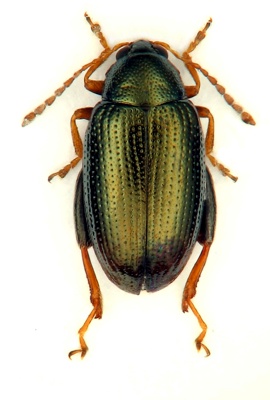Pests
Psylliodes attenuatus (Koch) - Hop Flea Beetle
Systematic position.
Class Insecta, order Coleoptera, family Chrysomelidae, genus Psylliodes Latr.Synonyms.
Macrocnema Steph.; Macrocnema apicalis Steph.; Psylliodes picicornis Steph.; Psylliodes japonica Jacoby.Biological group.
Pest of hemp and hop.Morphology and biology.
Body length, 1.8-2.6 mm. Body oblong-suboval, moderately convex, bronze-green with reddish apical part of elytra. Frontal furrows are deep and distinct, forming a criss-cross between eyes. Antenna 10-segmented, reddish-brown, its apical segments slightly darkened. Elytra without humeral callus, elytral striae are deep and distinct, interstriae fine punctuated. Hind tibia weakly curved, its apex covered with equal spinules. Hindtarsus insertion located proximally of the apex of tibia. The first tarsomere of the hindtarsus is straight from the side view and longer than the second one. Eggs are suboval, light yellow. Usually larva feeds on roots of Cannabis sp., Humulus sp., Urtica sp., often injuring underground part of the stalk. It consumes lateral roots and gnaws furrows on the main root. Mature larva length is about 3.5 mm. Larval 9th abdominal tergite with 10 long setae; its apical margin is rounded.Distribution.
Europe, Middle East, Asia Minor, China, Japan. In the former USSR, the species inhabits all territories of the European part northward to Baltic States, Karelia, and Kirov Region, including the Caucasus, Middle Asia, Kazakhstan, and Southern part of Siberia and Far East.Ecology.
Monovoltine. Adults survive after frost about -25°C. Overwintered beetles appear in March-April. They are light-requiring insects preferring fields and meadows with moderate arid conditions. Before hemp sprout appearance, they feed mainly on hop and nettle. Sometimes they are marked on tomato, potato, beet, flax, burdock, absinth, and frost-blite. After the temperature falls, the adults concentrate on the soil surface and damage stems. Mating begins after the short period of additional feeding. Female lays eggs in soil around host plants at a depth to 8 cm. Fertility is about 300 eggs. Egg develops in 6-20 days; optimal soil humidity for embryogenesis is about 40%. Larva has 3 instars and develops in 21-42 days. Pupation occurs inside the soil cradle; its development lasts 6-34 days. Young beetles emerge usually in August. At that time adults consume apical leaves and immature seeds of hemp. Diapause begins in September-October. Pest density depends on the conditions during hibernation, on soil humidity during egg and larva stages, and on parasites (Perilitus bicolor Weise infest sometimes to 60% of adults).Economic significance.
Damages in adult stage. Beetles gnaw numerous holes on leaves, sometimes skeletonizing them entirely. As a result, hemp seed production and stalk length decrease and duration of the plant development is delayed. Damage of the cotyledonous leaves is most dangerous in drought conditions, causing death of seedlings. Control measures include the use of fertilizers for acceleration of seedling development, the utilization of plant remainder in early spring or after harvesting, and cultivating of resistant hemp varieties. Insecticide treatment is necessary at high pest abundance. It is more effective 1-2 days before seedling appearance or after appearance of sprouts with 3 pairs of true leaves.Reference citations:
Baertueva V.A. 1973. Fauna and ecology of flea beetles (Coleoptera, Chrysomelidae, Halticinae) of Buryatskaya ASSR. In: Kulik A.S., ed. Fauna and ecology of insects from the East Siberia and Far East. Irkutsk: Irkutsk University. P. 44-55 (in Russian).Brovdii V.M. 1974. Family Chrysomelidae. In: Vasil.ev V.P., ed. Pests of agricultural crops and forest plantations. V. 2. Arthropods. Kiev: Urozhai. p. 49-88 (in Russian).
Bychko A.S. & Kurilenko N.I. 1982. Time constraints of the chemical treatment against Psylliodes attenuata Koch. In: Senchenko G.I., ed. Biological peculiarities, technology of growing and preprocessing of hemp. Collection of proceedings. Glukhov: Izd. VNII of Fiber crops. p. 57-62 (in Russian).
Dmitriev G.V. 1935. Psylliodes attenuata Koch in the right-bank territory of the Kuibyshev Region. In: Gabchenko G.D., ed. Zashchita rastenii (5). Proceeding of the VIZR. Moscow-Leningrad: 91-107 (in Russian).
Gaidar V.L. 1973. Fauna and ecology of flea beetles (Coleoptera, Chrysomelidae, Halticinae) of Irkutsk Region. In: Kulik A.S., ed. Fauna and ecology of insects from the East Siberia and Far East. Irkutsk: Irkutsk University. p. 56-68 (in Russian).
Kryzanovskii O.L. 1981. Family Chrysomelidae. In: Kopaneva L.M., ed. Key to harmful and useful insects and mites of industrial crops in the USSR. Leningrad: Kolos. p. 127-138 (in Russian).
Lopatin I.K. & Kulenova K.Z. 1986. Leaf beetles (Coleoptera, Chrysomelidae) from Kazakhstan. Alma-Ata: Nauka. 199 pp (in Russian).
Lopatin I.K. & Nesterova O.L. 2005. Insects of Belarus: Coleoptera, Chrysomelidae. Monography. Minsk: Tekhnoprint. 294 pp (in Russian).
Lopatin I.K. 1977. Leaf beetles (Chrysomelidae) from Middle Asia and Kazakhstan. Leningrad: Nauka. 289 p. (in Russian).
Medvedev L.N. 1992. Family Chrysomelidae / In: P.A. Ler, Ed. Keys to insects from the Far East of the USSR. V. 3. Coleoptera, or beetles. Part 2. St. Petersburg: Nauka. p. 533-602 (in Russian).
Palii V.F. 1961. Fauna of pest flea beetles of the USSR. Frunze: AN Kirgiz.SSR. 101 p. (in Russian).
Shapiro D.S. 1963. Fauna of flea beetles of the genus Psylliodes Latreille of the European part of USSR (Coleoptera, Chrysomelidae). In: Medvedev S.I., ed. Proceedings of Kharkov University. N 36. Kharkov: Kharkov University. p. 82-107 (in Russian).
Shernin A.I. 1974. Order Coleoptera. In: Shernin A.I. ed. Fauna of the Kirov Region (2). Kirov: Kirov Ped. Inst. p. 111-227 (in Russian).


